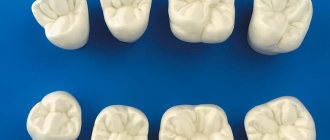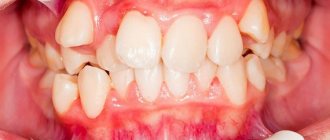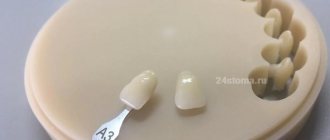Good teeth are more than just an attractive smile. This is also an opportunity to live without major prosthetics for a long time. However, sometimes anomalies in the shape of teeth occur during growth, and the identification of these developmental anomalies is more important for early diagnosis and appropriate treatment.
Below you will find out what violations of the correct shape of teeth are, and what methods are used for their diagnosis and treatment. You can also find out how to treat your teeth quickly and painlessly in Odessa.
What it is?
Teeth of this shape are found in one person in a thousand. Abnormal development most often brings not only psychological discomfort, but also causes permanent injury to the soft tissues of the oral cavity.
As a rule, this form is observed with supernumerary and hypoplasia .
Photo of conical teeth
External manifestations
Such teeth are characterized by special signs that will allow you to determine the anomaly even during self-examination:
- have the shape of a cone, pointed towards the cutting part;
- the inclination of all sides is most often the same, which does not allow identifying the vestibular or distal side;
- in some situations, a tubercle is formed on the vestibular surface, which is weakly expressed or takes the shape of a barrel;
- the cutting part has a maximum sharpness, leading to frequent damage to the oral mucosa;
- the size is slightly smaller than the rest of the teeth located in the general row;
- often susceptible to hypoplasia.
Which teeth are susceptible to pathology?
This anomaly is characterized by central localization in the upper jaw. As a rule, pathological teeth acting as supernumerary teeth are localized between the central and lateral incisors.
If the occurrence of an anomaly was provoked by another pathology, then the incisors, both central and lateral, may erupt in place.
In this case, the shape of the teeth of both the upper and lower jaws is modified .
You will learn how to treat fused teeth in the next review.
The next article will talk about diagnostic methods used in dentistry.
We will consider the concept of macrodentia of teeth at the link https://orto-info.ru/zubocheliustnye-anomalii/zubov/razmera/makrodentiya.html. What is the risk of this pathology?
What symptoms of a wedge-shaped defect should you pay attention to?
Painful sensations during caries appear when destroyed dental tissues (the so-called carious cavity) are no longer able to protect the neurovascular bundle located in the pulp chamber. With a non-carious defect, the affected area and decaying dentin are covered by the gum, and the walls of the formed wedge-shaped cavity remain smooth and hard. Therefore, the patient does not begin to experience unpleasant sensations immediately, but only in the third or fourth stages. Treatment of advanced pathology turns out to be more complex, costly, and in some cases ineffective.
Therefore, you should definitely see your doctor if you have:
- individual teeth have become hypersensitive and react to external irritations with sharp, piercing pain;
- the enamel has become cloudy, pale or more pigmented;
- The gum line has changed and the necks of the teeth are exposed.
Causes
the main reasons provoking the improper development of the form were identified .
These include:
- atavism . Explained by a genetic change in DNA, which leads not only to a change in the shape of the teeth, but also to their over-stuffing;
- splitting of the rudiment due to improper formation of its plate, which subsequently leads to an anomaly;
- general diseases leading to metabolic disorders;
- severe lack of vitamin D , which affects the proper formation of bone tissue;
- nephrotic syndrome;
- rubella, syphilis , autoimmune diseases;
- excessively low weight of the child or his prematurity .
Prevention of the development of dental anomalies
Anomalies in the shape of teeth are an irreversible process, but complex treatment makes it possible to eliminate deviations, recreate the correct anatomical shape of teeth, restore the functioning of the dental system and improve the appearance of teeth.
Prevention of the development of abnormalities in the shape of teeth is to ensure the normal development of the child inside the womb, as well as providing care and maintaining his health.
Preventive measures are aimed at ensuring a balanced diet, timely correction of endocrine system disorders and treatment of infectious and chronic diseases. We advise you to regularly visit your dentist for the prevention and timely diagnosis of dental development disorders.
Kinds
Clinical observations have made it possible to identify several types of such conical teeth. Each of them has its own clinical picture and structural features.
Spine-shaped
They are teeth, the crown part of which has a very narrowed cone-shaped shape, reminiscent of a spike. The base has a small width, most often only slightly larger than the standard dimensions.
Spike-shaped teeth are characterized by both a decrease in the length of the crown part and its elongation to gigantic sizes. The root has a noticeable shortening and narrowing, which is often the reason for loosening.
They are formed in the form of rudiments of the lateral incisors of the upper jaw. Basically, the cause of this anomaly is ectodermal dysplasia or cleft palate .
In addition to the irregular shape, there are large interdental spaces formed due to the small size of the rudiments.
Hutchinson
The reason for the development of such an anomaly is systemic hypoplasia, which leads to a modification of the shape, which becomes barrel-shaped or in the form of a screwdriver.
The main difference between Hutchinson's teeth is that on the cutting part there is a small notch in the shape of a semicircle or crescent. As a rule, it is covered with enamel, only along the side surface.
At the bottom of the hole, the enamel is thinned or completely absent. Most often, such an anomaly is observed on the incisors of children whose mother suffered from rubella or syphilis during pregnancy.
Pflueger
Unlike previous species, it affects mainly premolars, the appearance of which begins to resemble an unopened bud.
In addition to the irregular barrel-shaped shape, visible changes in the surface layer are observed, on which numerous microdefects are clearly displayed in the form of dots, dimples and horizontal grooves.
The tooth is distinguished by an unusually enlarged cutting part and neck, as well as underdevelopment of the masticatory tubercles. In addition to external manifestations, the anomaly is characterized by thinning of dentin, which leads to constant high sensitivity.
Problems that pathology leads to
An awl-shaped tooth in a child or adult is not only an aesthetic and psychological problem. A person with this defect can constantly injure the oral mucosa, which in turn is fraught with stomatitis, gingivitis and periodontitis, the formation of painful and poorly healing ulcers and their degeneration into malignant tumors.
An abnormal form can become a prerequisite for the formation of malocclusion, as well as the cause of poor-quality chewing of food, dysfunction of the maxillofacial apparatus, and problems with the gastrointestinal tract.
On a note! If spike-shaped teeth are supernumerary, then they provoke a phenomenon called crowding. When overcrowding occurs, high-quality hygienic oral care is difficult; small pieces of food are poorly removed from the spaces, which leads to increased accumulation of bacterial plaque, the appearance of halitosis, caries and gingivitis.
The defect is often accompanied by enamel hypoplasia, which means that hard tissues are very vulnerable and sensitive to any external influences and bacteria. The enamel in patients with this problem is quickly destroyed and is susceptible to caries and its complications (pulpitis, periodontitis).
Treatment methods
Modern diagnostic capabilities make it possible to detect the disease at an early stage. In particular, the most complete information about the shape and size of teeth can be obtained using cone tomography.
To treat anomalies, several methods are used that can visually eliminate the problem. All of them can be used only after the formation of a permanent bite .
These methods include:
- prosthetics using crowns made on the basis of metal-ceramics, which fully conveys the color and structure of the enamel. It is carried out with mandatory volumetric preparation of dental tissues;
- application of veneers .
They are thin ceramic plates designed for fixation to the vestibular surface. The main advantage of this method is that the preparation is minimal and gentle; - composite restoration . It is a cheaper alternative to veneers. Before the procedure, a small preparation of up to 1.5 mm is also carried out, after which a light-curing composite is applied layer by layer;
- removal . Most often it is used for supernumerary or abnormally large teeth, after the removal of which the row is restored with prosthetics.
How wisdom tooth dystopia manifests itself, read in a new publication.
In this article we will tell you who a pediatric orthodontist is.
Here https://orto-info.ru/zubocheliustnye-anomalii/zubov/kolichestva/skuchennost-i-sposobyi-ustraneniya-problemyi.html we will talk about the effectiveness of methods for treating crowded teeth.
Possible consequences
If treatment of spiky teeth is not carried out or correction is performed incorrectly, then the likelihood of complications developing is very high. The disease progresses and reduces the protective properties of the enamel layer. This provokes the following negative consequences:
- sensitivity increases significantly;
- carious disease is rapidly developing;
- pathological closure of teeth (bite) is formed;
- the rate of enamel wear increases;
- gradual damage to deep tissue layers;
- loss of teeth.
All these processes gradually disrupt digestive reactions and lead to the development of chronic pathologies of the digestive system.
Doctor's advice
To reduce the risk of enamel malformation, women need to closely monitor their health during pregnancy. It is recommended to avoid contact with infected people, maintain a balanced diet, and eliminate bad habits. After the birth of a child, it is important to visit the pediatrician in a timely manner and carry out home cleaning from the moment the first tooth erupts. You should visit a pediatric dentist for a preventive examination every 3-4 months, starting from 1 year of age.











